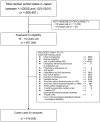Physician presence in an ambulance car is associated with increased survival in out-of-hospital cardiac arrest: a prospective cohort analysis
- PMID: 24416232
- PMCID: PMC3885569
- DOI: 10.1371/journal.pone.0084424
Physician presence in an ambulance car is associated with increased survival in out-of-hospital cardiac arrest: a prospective cohort analysis
Abstract
The presence of a physician seems to be beneficial for pre-hospital cardiopulmonary resuscitation (CPR) of patients with out-of-hospital cardiac arrest. However, the effectiveness of a physician's presence during CPR before hospital arrival has not been established. We conducted a prospective, non-randomized, observational study using national data from out-of-hospital cardiac arrests between 2005 and 2010 in Japan. We performed a propensity analysis and examined the association between a physician's presence during an ambulance car ride and short- and long-term survival from out-of-hospital cardiac arrest. Specifically, a full non-parsimonious logistic regression model was fitted with the physician presence in the ambulance as the dependent variable; the independent variables included all study variables except for endpoint variables plus dummy variables for the 47 prefectures in Japan (i.e., 46 variables). In total, 619,928 out-of-hospital cardiac arrest cases that met the inclusion criteria were analyzed. Among propensity-matched patients, a positive association was observed between a physician's presence during an ambulance car ride and return of spontaneous circulation (ROSC) before hospital arrival, 1-month survival, and 1-month survival with minimal neurological or physical impairment (ROSC: OR = 1.84, 95% CI 1.63-2.07, p = 0.00 in adjusted for propensity and all covariates); 1-month survival: OR = 1.29, 95% CI 1.04-1.61, p = 0.02 in adjusted for propensity and all covariates); cerebral performance category (1 or 2): OR = 1.54, 95% CI 1.03-2.29, p = 0.04 in adjusted for propensity and all covariates); and overall performance category (1 or 2): OR = 1.50, 95% CI 1.01-2.24, p = 0.05 in adjusted for propensity and all covariates). A prospective observational study using national data from out-of-hospital cardiac arrests shows that a physician's presence during an ambulance car ride was independently associated with increased short- and long-term survival.
Conflict of interest statement
Similar articles
-
Benefits of adding a physician-staffed ambulance to bystander-witnessed out-of-hospital cardiac arrest: a community-based, observational study in Niigata, Japan.BMJ Open. 2019 Nov 26;9(11):e032967. doi: 10.1136/bmjopen-2019-032967. BMJ Open. 2019. PMID: 31772105 Free PMC article.
-
Prehospital lactated ringer's solution treatment and survival in out-of-hospital cardiac arrest: a prospective cohort analysis.PLoS Med. 2013;10(2):e1001394. doi: 10.1371/journal.pmed.1001394. Epub 2013 Feb 19. PLoS Med. 2013. PMID: 23431275 Free PMC article.
-
Prehospital epinephrine use and survival among patients with out-of-hospital cardiac arrest.JAMA. 2012 Mar 21;307(11):1161-8. doi: 10.1001/jama.2012.294. JAMA. 2012. PMID: 22436956
-
Community first responders for out-of-hospital cardiac arrest in adults and children.Cochrane Database Syst Rev. 2019 Jul 19;7(7):CD012764. doi: 10.1002/14651858.CD012764.pub2. Cochrane Database Syst Rev. 2019. PMID: 31323120 Free PMC article.
-
Outcomes of out-of-hospital cardiac arrest in patients with SARS-CoV-2 infection: a systematic review and meta-analysis.Eur J Emerg Med. 2021 Dec 1;28(6):423-431. doi: 10.1097/MEJ.0000000000000878. Eur J Emerg Med. 2021. PMID: 34690258 Free PMC article.
Cited by
-
Influence of EMS-physician presence on survival after out-of-hospital cardiopulmonary resuscitation: systematic review and meta-analysis.Crit Care. 2016 Jan 9;20:4. doi: 10.1186/s13054-015-1156-6. Crit Care. 2016. PMID: 26747085 Free PMC article.
-
Benefits of adding a physician-staffed ambulance to bystander-witnessed out-of-hospital cardiac arrest: a community-based, observational study in Niigata, Japan.BMJ Open. 2019 Nov 26;9(11):e032967. doi: 10.1136/bmjopen-2019-032967. BMJ Open. 2019. PMID: 31772105 Free PMC article.
-
Analysis of out-of-hospital cardiac arrest in Croatia - survival, bystander cardiopulmonary resuscitation, and impact of physician's experience on cardiac arrest management: a single center observational study.Croat Med J. 2016 Dec 31;57(6):591-600. doi: 10.3325/cmj.2016.57.591. Croat Med J. 2016. PMID: 28051284 Free PMC article.
-
Novel and innovative resuscitation systems in Japan.Resusc Plus. 2023 Dec 30;17:100541. doi: 10.1016/j.resplu.2023.100541. eCollection 2024 Mar. Resusc Plus. 2023. PMID: 38260120 Free PMC article. Review.
-
Benefits of targeted deployment of physician-led interprofessional pre-hospital teams on the care of critically Ill and injured patients: a systematic review and meta-analysis.Scand J Trauma Resusc Emerg Med. 2025 Jan 6;33(1):1. doi: 10.1186/s13049-024-01298-8. Scand J Trauma Resusc Emerg Med. 2025. PMID: 39757222 Free PMC article.
References
-
- Lossius HM, Soreide E, Hotvedt R, Hapnes SA, Eielsen OV, et al. (2002) Prehospital advanced life support provided by specially trained physicians: is there a benefit in terms of life years gained? Acta Anaesthesiologica Scandinavica 46: 771–778. - PubMed
-
- Skogvoll E, Bjelland E, Thorarinsson B (2000) Helicopter emergency medical service in out-of-hospital cardiac arrest - a 10-year population-based study. Acta Anaesthesiologica Scandinavica 44: 972–979. - PubMed
-
- Edelson DP, Litzinger B, Arola V, Kim S, Lauderdale DS, et al. (2008) Improving in-hospital cardiac arrest process and outcome with performance debriefing. Arch Intern Med 168: 1063–1069. - PubMed
-
- Hampton JR, Dowling M, Nicholas C (1997) Comparison of results from a cardiac ambulance manned by medical or non-medical personnel. Lancet 1: 526–529. - PubMed
-
- Baxt WG, Moody P (1987) The impact of a physician as part of the aeromedical prehospital team in patients with blunt trauma. JAMA 257: 3246–3250. - PubMed
Publication types
MeSH terms
LinkOut - more resources
Full Text Sources
Other Literature Sources
Miscellaneous


